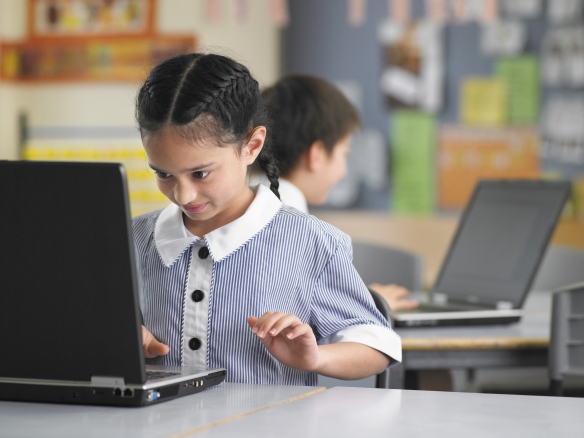It is widely agreed that technology is the essence of innovation in today’s society. Every day, a new app or gadget is brought to the market that serves to make our lives easier in some way, and the education system is no exception. In fact, technology is moving at such a pace that in schools ICT is no longer a lesson to be taught, but a tool that is imperative for the teaching and learning of other subjects.
Laptops, tablets, and other mobile devices have become essential learning tools of today’s classroom in all subjects, providing easy and fast fingertip access to a world of knowledge unavailable to previous generations of pupils. With the increase of BYOD – the umbrella term describing the learning method by which students and teachers take in their own mobile device – school supplied computers are becoming less important, possibly in a similar way that the advance of classrooms’ interactive whiteboards rendered blackboards obsolete. Moreover, the concept of 1:1 learning, which refers to every pupil having a device that they can take home at the end of the day and continue to use for both educational and personal purposes, is becoming a growing trend in classrooms across the country.
With BYOD and online learning aids becoming the norm, pupils in lessons will undoubtedly need vast network capacity, as they simultaneously require broadband access, and may also have multiple devices running multiple applications, all using network resources. To support this demand, many schools are beginning to implement a Managed Wireless Network (MWN). A MWN is a system that allows for a more powerful and capacious network through the use of faster access points, a wireless AC standard and band steering.
Furthermore, virtual reality is also a now growing aspect of classroom learning and can contribute a key role in providing students with an active rather than passive experience, through fully immersing them in an engaged learning experience with minimal distractions. From William Shakespeare appearing before students’ eyes in order to provide an analysis of one of his plays as students watch it, to students feeling like they are in a real life laboratory when performing a science experiment, virtual reality enables students to be transported to another world through the use of feedback headsets, tactile gloves and motion sensors, helping create a memorable learning experience.
It is important to consider that the security that schools use to protect their staff and pupils is also evolving, in line with new-generation networks. IP surveillance is paving the way for the future of school security systems, in particular IP surveillance, which is the digitalised, networked HD version of CCTV. With IP surveillance, authorised users can see recorded video from any camera, accessing images via their PC, or any mobile device. Such a system provides the flexibility of multiple views and angles, unlimited storage and easier search and retrieval.
However, a greater amount of technology in classrooms may also have some drawbacks.
For instance, it is unknown if a network will be able to cope with an influx of devices and what upgrades, improvements or complete rebuilds would be necessary to future-proof any systems installed or considered. Not to mention the fact that new technology drives significant change in the relationship between teacher and student and this also needs taking in to account. D-Link networks are easy to set up, use, and understand, serving to overcome this issue.
Inevitably, increased time spent online also leaves children more vulnerable to cyber bullying, offensive material, and radicalisation. Therefore, it is vital that policy emphasises issues such as permitted sites and devices, agreed hours of use, mandatory check-in procedure for student’s devices, and the consequences of inappropriate use. There is also the need for constant reconsideration of policy content and adaption to changing circumstances by renewing it regularly, as technology continues to evolve.
Overall, the future of technology in education appears to be about access, anywhere learning, and collaboration, both locally and globally, as well as a network robust enough to support the new demands placed upon it. With the introduction of many innovative systems and a changing attitude to the importance of technology in the classroom, it is apparent that technology has the power to transform how people learn.
